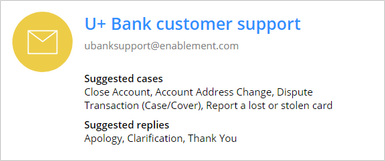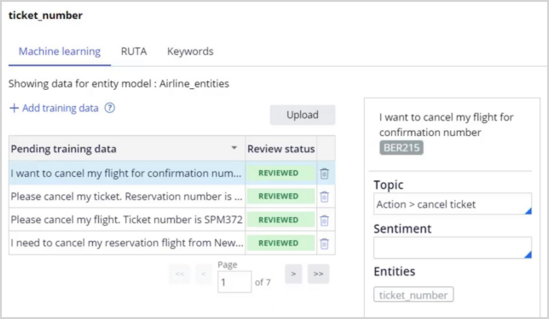
Pega NLP overview
Introduction
Pega natural language processing (NLP) focuses on text categorization and text extraction. Discover how the system uses Pega NLP to route incoming emails based on the topic of the email, and how NLP drives a chatbot to automatically detect the topic of the message, extract necessary entities, create a case, and then route it to the correct customer service workbasket.
Video
Transcript
This video introduces you to Pega NLP, a feature of the decision management capability of Pega Platform. You can apply decision management to any application that uses Pega Platform, which makes it highly versatile.
Pega NLP uses text analytics predictions to detect the topic and entities that are included in the message. For example, a company has an email channel where its customers can send any email.
A text prediction drives the email channel. Consider this email sent by the customer through the company's email channel. The text prediction aims to detect the topic of the email and route it to the appropriate department.
Apart from the topic detection model, the prediction also includes an entity extraction model that can extract entities from an email. It can automatically detect and extract certain entities such as an account number, email address, or street address. This functionality allows to automatically process or prioritize emails.
In addition to topic detection and entity extraction, Pega NLP detects the sentiment of an email based on its content. The sentiment score ranges from -1 to 1 and is negative, positive, or neutral.
This functionality offloads work from customer service representatives, speeds up the process, and improves the customer experience.
Multiple channels can use the Pega NLP feature. For example, an airline sets up a chatbot channel to speed up customer service by automating the ticket cancellation process.
When Troy, a customer, sends a message to the Airline chatbot that he wants to cancel his ticket, the text prediction detects the topic of the message and runs the Cancel a ticket case type that an application developer preconfigured in the system. The case type contains the conversation flow that the chatbot uses in conversation with Troy. The chatbot uses entity extraction models to detect entities such as the ticket number, includes all necessary information in a case, and routes it to a correct customer service workbasket.
In App Studio, you can test the chatbot in the preview console.
You can turn on the Show Analysis switch to see the chatbot details. Notice the customer's message. The topic detection model detects the topic of this message with 91 percent confidence, and the entity extraction model identifies the ticket number. Chatbot collects this information, includes it in a case, and then automatically routes it to a customer service representative for further processing.
Predictive models drive predictions. A data scientist manages predictions in Prediction Studio.
Prediction Studio is the dedicated workspace in Pega Platform where you manage the life cycle of predictive models and the predictions that they drive.
The workspace provides data scientists with everything they need to monitor and change predictions.
This is the Predictions landing page, where you manage predictions. Pega NLP uses Text analytics predictions.
Data scientists build topic detection model in a text prediction by using training data that they add manually or as a batch.
Data scientists also configure entity extraction in a text prediction. Several methods are available, including machine learning, Ruta scripts, or keyword-based entity extraction. It is also possible to use Google AutoML models. The machine learning-based model is the most versatile but requires training data to function. When adding entity extraction training data, you can also specify the topic of each message to further enhance the topic detection model.
You have reached the end of this video. You have learned:
- How Pega NLP allows you to improve business processes by using predictions.
- How topic and sentiment detection models and entity extraction models drive text analytics predictions.
- That machine learning models require training data.
This Topic is available in the following Modules:
If you are having problems with your training, please review the Pega Academy Support FAQs.
Want to help us improve this content?




